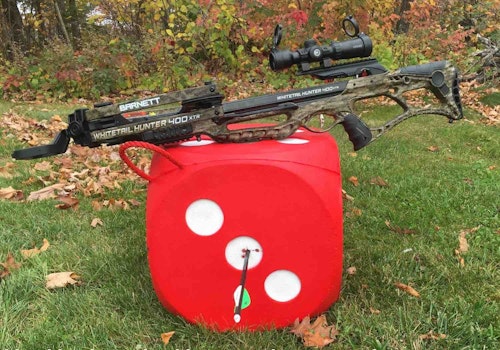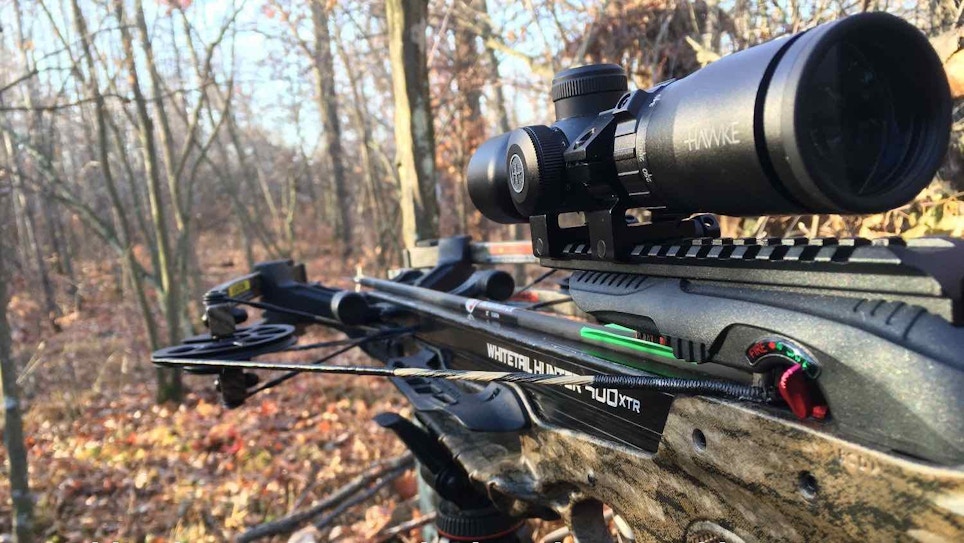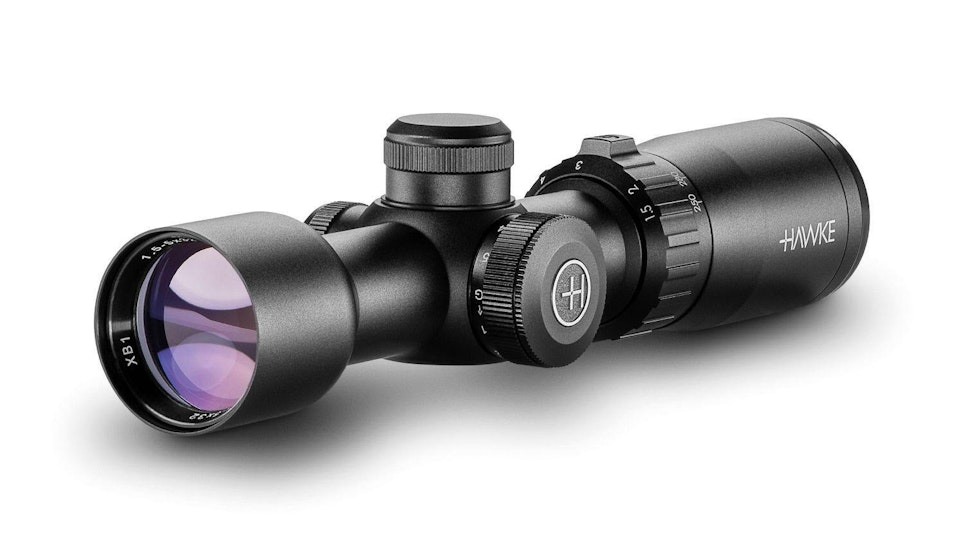I’ve hunted with a crossbow from Minnesota to Texas, and along the way I’ve used scopes ranging in price from well under $100 to well over $1,000. The least-expensive ones were designed for firearms not crossbows; the owner’s manuals didn’t mention anything about crossbows when adjusting windage and elevation. These scopes were included in crossbow packages. The expensive crossbow scopes I’d used had complicated reticles and didn’t offer magnification adjustments.
Almost all crossbow scopes regardless of price are fixed magnification, 4x as a rule. This magnification is fine for shots of 20 to 30 yards, which is the maximum distance in which I’ll shoot at a deer. Yes, almost all crossbows are tremendously accurate at longer ranges, but due to the loud noise of a fired crossbow, the chance of a big game animal jumping the string (crouching as it begins to run) is simply too great in my opinion to risk a shot beyond 30 yards. Sure, a deer can jump the string at closer ranges, too, but I feel better about hitting an alert deer’s heart/lung area at 15 yards vs. 45 yards.
One of my biggest complaints regarding fixed-power 4x scopes is they don’t provide enough field-of-view at ranges closer than 15 yards. I often bowhunt public land with thick cover from natural ground blinds, and sometimes my shot distance to a deer trail is only 7-10 yards. When a deer steps into my narrow shooting lane at 7 yards, and I’m looking at it with a 4x scope, I can’t even see the deer’s backline and bellyline. The entire reticle is filled with brown deer hair, which makes it difficult to find a precise aiming point. For these scenarios, I always longed for a scope with little to no magnification.
Researching Crossbow Scopes
Last winter I vowed to find a better crossbow scope system for my style of hunting prior to the 2022 deer season. I spent hours online researching the topic, and I finally decided to try the Hawke XB1 1.5-5x32 SR crossbow scope. In terms of price, this isn’t a cheap scope, but I don’t consider it expensive, either; MSRP is $199 and street prices range from $160 to $190.
What first caught my eye was the Hawke XB1’s variable power: 1.5-5x. I liked the idea of adjusting the magnification ring to 1.5x for close-range scenarios (15 yards and less) and then turning up the magnification to 5x for 20- to 30-yard shots. This ability to adjust the magnification based on my hunting scenario was the primary reason I chose the Hawke XB1.
Now this is an important point: The XB1’s magnification ring also serves as a “speed ring.” Let me explain. The XB1 SR reticle features aiming points from 20 yards to 100 yards, and these aiming points are valid after you set the magnification/speed ring to the corresponding speed of your crossbow, from 250 to 425 fps. Hawke refers to this process as “calibrating the scope.” Example: My crossbow shoots 400 fps, so if I set the magnification/speed ring to 400 fps, and sight-in my crossbow at 30 yards so it matches the 30-yard crosshair, then all of the other aiming points (20 yards to 100 yards) should be correct, provided I don’t change the magnification/speed ring setting. In other words, I’d have to use the XB1 as a fixed-power scope for that specific magnification/speed setting. For my bow’s speed of 400 fps, that magnification/speed setting would be nearly 5x.
Another example: Let’s say my crossbow sent arrows downrange at only 250 fps. This speed would correspond to 1.5x on the XB1’s magnification/speed ring, so all the other aiming points would work (after calibrating the scope at 30 yards, per Hawke recommendations) for 20 yards to 100 yards. If a hunter used the XB1 as a fixed 1.5x scope and never changed the magnification/speed ring, those aiming points would be valid.
I do not — let me repeat — I do not — use the magnification/speed ring in this manner. I’m not interested in setting the magnification/speed ring to the speed of my 400 fps crossbow and then leaving it at that setting forever. I couldn’t care less about using the aiming points of 40 yards to 100 yards. For my use, these aiming points might as well be missing. I want to change the magnification setting based on each hunting scenario.

My Sight-In Procedure
After mounting the Hawke XB1 to my Barnett Whitetail Hunter 400 XTR crossbow, I shot one arrow from 7 yards to ensure I wouldn’t miss the target and destroy an arrow on my basement’s concrete wall. I shot this arrow with the magnification ring set to 1.5x. Because the arrow was reasonably close to the bull’s-eye, I stepped back to 20 yards (the full length of my basement archery range) and fired another arrow. For this shot, I set the magnification ring at 5x. After checking arrow impact in relation to the bull’s-eye, I adjusted the scope’s windage and elevation based on the owner’s manual. instructions (at 20 yards, 10 clicks moves arrow impact 1 inch). After a couple more shots, I had the crossbow sighted-in at 20 yards.
My next step was going to my backyard range to determine whether the second aiming point, which is labeled in the reticle as 30, did in fact match with a range of 30 yards. With the scope magnification set at 5x, I used the reticle’s 30-yard aiming point and fired an arrow. Because this arrow centerpunched the bull’s-eye, I was good to go. Note: It was certainly convenient that the 30-yard aiming point coincided with a distance of 30 yards from my specific crossbow. This wasn’t a surprise because on the magnification/speed ring, the setting of 5x corresponds to 425 fps, and my bow shoots very close to this speed at 400 fps.
My goal in testing the second aiming point (marked “30” in the reticle) was to determine its true distance for my crossbow and arrow combo (125-grain field point). If the second aiming point had proved to be dead-on at 25 yards, or 35 yards, it didn’t really matter to me. As long as I knew the true yardage represented by the second aiming point, I could work with it in the deer woods.
Next, I moved up to 10 yards, adjusted the magnification to 1.5x, and fired an arrow (using the primary 20-yard aiming point). Again, my arrow centerpunched the bull’s-eye. Finally, I moved to 15 yards, adjusted the magnification to about 3x, and fired an arrow (using the primary 20-yard aiming point). Again, my arrow was dead center in the bull’s-eye.
In summary, I use the primary 20-yard aiming point on the XB1 for everything from 5 to 20 yards, and it doesn’t matter which magnification setting I use. It’s dead-on with the magnification set from 1.5x to 5x and everything in between. At 25 yards, I set the magnification at 5x and “bracket” between the 20- and 30-yard aiming points. At 30 yards, with the magnification at 5x, I use the 30-yard aiming point. As I said previously, I’m not interested in shooting long range (40 to 100 yards).
XB1 Favorite Features
In addition to the variable power, one feature I’ve really like on the XB1 is the red and green reticle illumination. I prefer the green. I’ve owned less-expensive crossbow scopes with green illumination but the entire reticle filled with a hazy green color when it was activated, making the scope useless — I couldn’t distinguish any objects. That’s not the case with the XB1. During the first and last 10 minutes of legal hunting time, when I turn on the lowest level of the green illumination, only the “X” aiming point is colored green, and everything else around the “X” is clear, which is ideal. In testing the scope in low light, I can easily see the green “X” against dark tree trunks when the standard black “X” (no illumination) can’t be seen.
Final Thoughts
You can read about additional features and specs of the Hawke XB1 1.5-5x32 SR crossbow scope below. Of course, I can’t yet speak regarding the scope’s durability because at the time of this writing, I’ve used it for only a few months. That said, Hawke “guarantees this product to be free of defects in materials and workmanship for the lifetime of the original owner.” For me, a lifetime warranty equals peace of mind.
If you really want to learn what I think about this scope, know that I’ve recently told my mom and sister-in-law that a Hawke XB1 would be an excellent Christmas gift for my dad and brother. Like me, they’ve been searching for an optics upgrade on their crossbows, and I know they’d be extremely pleased.

Additional XB1 Features
- Waterproof, shockproof, and fogproof
- Fast-focus eyebell and high-torque zoom ring
- 1-inch mono-tube chassis for superior strength
- Rheostat on saddle offers five levels of brightness
- Glass-etched reticle with red and green illumination
- 11 layer fully multi-coated lenses for excellent clarity
- 1/2 MOA low-profile turrets for precision adjustments
- Speed selector ring calibrated for speeds from 250 to 425 FPS
- Flip-Up Lens Covers included
- CR2032 battery included
XB1 Specifications
- Magnification: 1.5–5x
- Objective Lens Diameter: 32mm
- Length: 8.3 inches
- Weight: 13 ounces
- Eye Relief: 3 inches
- Reticle: XB1 SR
- Material: Aluminum
- Focal Plane: Second
- Chassis: 1 inch mono-tube
- Parallax: Fixed @ 50 yards
- Illumination: Red/Green (Five levels)
- Field of View: 75–22.5 feet/100 yards
- Adjustment Click Value: 1/2 MOA
- Windage Adjustment Range: 120 MOA
- Elevation Adjustment Range: 120 MOA








